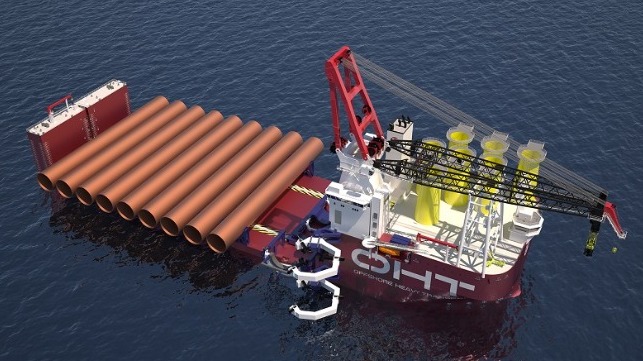“Unplanned” Crane Movement Could Delay New Wind Installation Vessel
October 27, 2021 Maritime Safety News

Crane builder Liebherr and offshore wind vessel operator Seaway 7 have experienced a setback in the construction of the monopile-installation vessel Alfa Lift. An “unplanned movement” of a key crane component aboard the new ship has prompted a technical investigation.
The Alfa Lift was ordered by offshore wind specialists OHT in 2018, long before OHT’s merger with Subsea 7’s renewables unit this July. Alfa Lift is a semisubmersible heavy lift crane ship, purpose-built for installing offshore wind tower foundations and transition pieces. It is equipped with a novel crane designed and built by German heavy lift manufacturer Liebherr, the HLC 150000.
This unique crane is designed to hoist the heaviest offshore wind foundations expected in the coming years, up to 3,000 tonnes. Its custom design features a foldable A-frame, which can be lowered to reduce the vessel’s air draft when needed – for example, when passing under Denmark’s Great Belt Fixed Link bridge, which restricts air draft for traffic between the North Sea and the Baltic.
The A-frame unit for the HLC 150000 shipped from Liebherr’s Rostock plant to China Merchants Heavy Industry’s Jiangsu shipyard in March, shortly after the Alfa Lift’s hull was launched. At the time, Liebherr said that its own technicians would be conducting the installation and commissioning.
“The crane can only be assembled and installed once the vessel has reached a specific phase in its construction. Therefore, the manufacturing timelines are finely balanced,” said Gregor Levold, marine sales director at Liebherr Rostock. “Due to the extensive experience of our experts, a team of Liebherr specialists will travel to China and support with supervision for the installation, commissioning and testing process (ICT) of the HLC 150000 at the shipyard.”
On Monday, Seaway 7 announced that it has been informed of an incident involving the folding A-frame on the HLC 150000 crane aboard the Alfa Lift. The company described it as an “unplanned movement,” and said that no personnel were injured. The cause of the incident is under investigation.
“The incident is a matter between the shipyard and crane vendor, and it is too early to indicate if this will have an impact on delivery schedule of the vessel,” the company said in a statement.
Alfa Lift has been chartered to install all of the monopile foundations for the UK’s Dogger Bank offshore wind farm, the largest project of its kind in the world. Dogger Bank’s first two phases will have a combined capacity of 2.4 gigawatts, achieved through the use of hundreds of gigantic GE Haliade-X turbines, each sitting atop a massive foundation. When complete, the project will be the UK’s largest single source of electricity. The construction timeline calls for Alfa Lift to be on site and working beginning next year, with first power from 2023.
Second incident since 2020
The “unplanned movement” is the second incident involving a Leibherr crane aboard a new offshore wind vessel in two years. In May 2020, the heavy crane aboard the offshore installation vessel Orion 1 suffered a hook failure during load testing, resulting in whiplash and boom collapse. Several people reportedly suffered injuries.
Operator DEME had been scheduled to take delivery of the ship within weeks, but due to the damage, the vessel’s delivery was pushed back into 2021. Orion 1’s entire boom and portions of her A-frame had to be rebuilt, according to Leibherr. As Orion 1 went out of action, her first contract went to the installation vessel Seajacks Scylla, which filled in to complete the construction of the Moray East windfarm off the coast of Scotland.
The hook for Orion 1’s crane had been procured from a third-party supplier, and it is likely that it was not tested at the factory before installation, according to consultancy SWZ Maritime.
SOURCE READ THE FULL ARTICLE
https://www.maritime-executive.com/article/unplanned-crane-movement-could-delay-new-wind-installation-vessel





